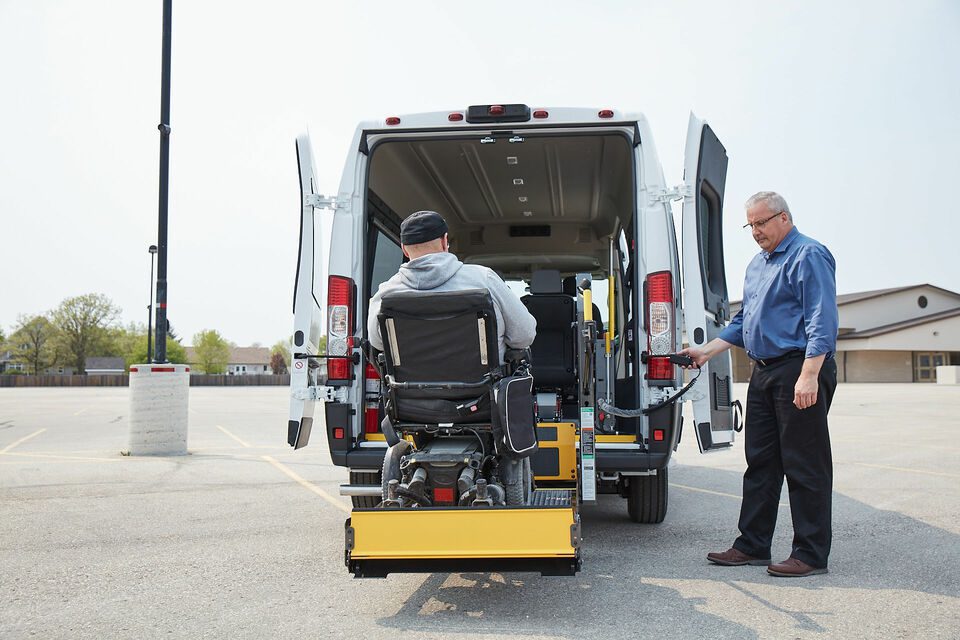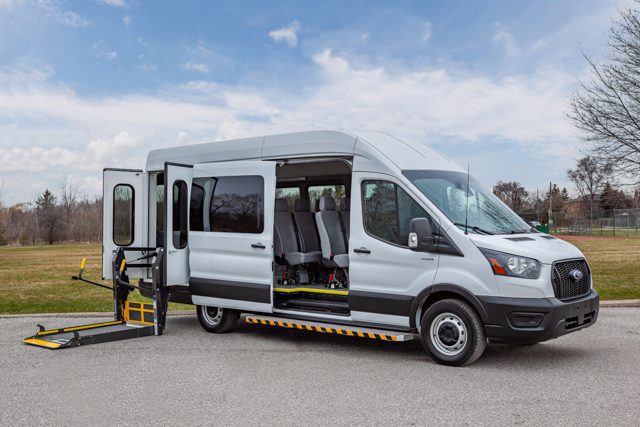Choosing between a rear entry vs. side entry wheelchair van is one of the most vital decisions your organization will make during the buying process.
This is because how wheelchair users and mobility passengers enter and exit the vehicle affects their everyday lives–and, by extension, your everyday life. So, making the wrong decision can make your everyday life extremely inconvenient.
At MoveMobility, we’ve helped hundreds of organizations like yours choose the right option for them over 10 years, so we know how to help you make this difficult decision.
In this article, you will compare rear entry vs. side entry full size vans, and you’ll learn a few questions you can ask yourself to help you make your decision.
Note: The information provided in this article is for full size vans only.
Rear entry vs side entry wheelchair vans: what’s the difference?
First, let’s establish what exactly we mean when we talk about ‘rear entry’ and ‘side entry’ vans.
We’re referring to the side which your passengers will enter and exit the vehicle from.
Rear entry means —passengers will enter the vehicle from the back of the vehicle using a ramp or a lift.
Side entry means —passengers will enter the vehicle from the side using a ramp.
Comparing rear vs. side entry full size vans

Parking
Rear entry uses the street or a driveway for loading/unloading
When you’re parking your rear entry van, we encourage you to use a parking lot or driveway. This is because if you park on the street, your passengers will have to load and unload onto the street, which can cause feelings of stress for them due to cars whizzing past.
You also have to make sure you have enough space behind you for your ramp or lift.
Side entry uses the curb/sidewalk for loading/unloading
When you’re parking your side entry van, you need to make sure you have enough space on the side for your ramp. A side entry van is best if your organization will be loading and unloading onto the curb/sidewalk.
Wheelchair access
Rear entry can be less difficult for loading/unloading wheelchair users
With a rear entry van, wheelchair users enter the vehicle from the back and go straight in/straight out of the vehicle.
This can make it easier for loading/unloading wheelchair users into the van.
Side entry can be more difficult for loading large wheelchairs
With a side entry van, wheelchair users enter from the curb and have to be turned 90 degrees to face forward. It can sometimes be difficult to turn wheelchairs that are heavier, and you should keep in mind that you will need space inside the van to be able to turn the wheelchair around.
Ambulatory passenger access
Rear entry means ambulatory passengers enter through the side doors
If the rear entry van has a rear lift or ramp, wheelchair users enter the vehicle through the back and ambulatory passengers enter through the side door.
Side entry provides easy access from the curb
A side entry van provides easy access right from the curb/sidewalk, meaning passengers can walk right up the ramp.
Cost
When it comes to rear vs. side entry full size vans, there really is no difference. It’s the same conversion just in a different location on the van. Check out this article to see how much a full size wheelchair van costs in 2023.
Rear entry vs. side entry wheelchair vans: which is right for me? (4 questions to ask)

After going through the pros and cons of rear and side entry wheelchair vehicles, you’re probably wondering what factors you should be looking for in your own organization/company that can help you make this difficult decision.
Here are a few questions to ask yourself as you weigh your options:
1. What is your parking situation?
If you’ll be parking the van in a narrow driveway or in parking lots without many available spaces, a rear entry wheelchair van may be right for you.
This is because you won’t need any additional space beside the vehicle for a wheelchair ramp.
2. What is the size and weight of the wheelchairs you will be transporting?
If any of your passengers use large or heavy wheelchairs, having them enter and exit through the back of the wheelchair van can be an easier option. You also wouldn’t have to turn the wheelchair around once inside the vehicle with a rear entry van.
To put it simply: if your wheelchairs are heavier, a rear entry wheelchair van may be easier for your staff to use.
3. What is your passengers’ level of mobility?
If your organization transports passengers with walkers or canes, they may feel uncomfortable using a lift.
A lift can make some passengers feel unsafe because of how it, well, lifts them into the air.
To combat this, you can choose a side entry ramp (or a rear entry ramp if your passengers are comfortable getting in and out of the van on a street or driveway).
4. How many passengers will you be transporting every day?
Determining how many passengers you will be transporting on an average day is also an important factor to consider.
This is because a side entry van is easier for lots of people to get in and out of quickly. For example, community transit programs may find a side entry van is best for frequent pick ups and drop off because it will be using the sidewalk.
Your next steps to choosing a rear entry vs. side entry wheelchair van
You came to this article to learn whether a side entry or rear entry minivan would be better for your organization/company.
Now, you know the pros and cons of both options, and a few questions to ask yourself that can help you make the decision.
Hopefully, you feel more informed about making this important decision.
But if you’re still not sure which option is right for you, talk to an expert now.
Or, if you’d like to do some more reading, check out these related articles:







